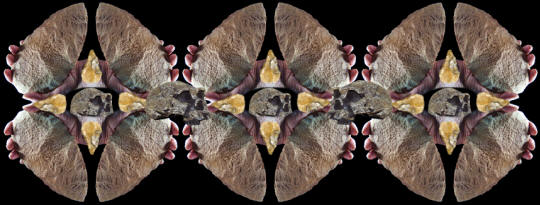|
Acheulean handaxes are referred to in literature as either
handaxes, bifaces, core tools or core-bifaces. Biface is the best
descriptive term because most handaxes are bifacially flaked into either
very thick or "not-so-thick" bifaces. The term biface was first used in
1920 by Vayson de Pradenne. Handaxes are also sometimes referred to as
core tools because they are produced by the removal of large flakes from
both surfaces of a nodule or cobble. A good percentage of these reduction flakes
were used as tools just as later core and blade industries produced
tools from flakes struck from cores.
|
|
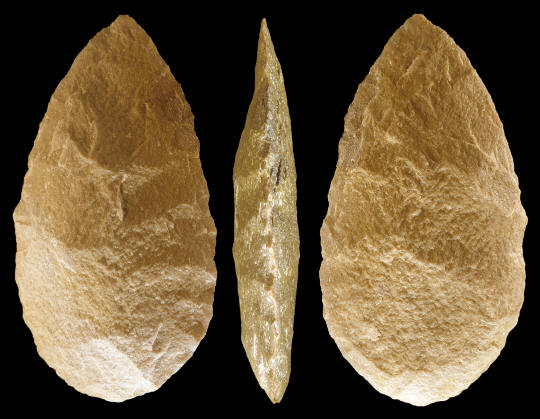
CLICK ON PICTURE FOR LARGER TRIPLE IMAGE
HANDAXE
ACHEULEAN
KALAMBO FALLS
SITE, AFRICA
NORTHERN ZAMBIA
LATE ACHEULEAN
UNIVERSITY
OF CALIFORNIA, BERKELEY, DEPARTMENT OF ANTHROPOLOGY COLLECTION
This
large handaxe was excavate on the Kalambo Falls site in northern Zambia
by Desmond Clark and dates to approximately 100,000 years ago. It
was probably made with a soft hammer percussion flaking tool that
might have
been made of either antler, bone, ivory or wood. This hand axe was uniformly
shaped along the edges by removing a large number of small flakes.
It's made of quartzite and measures 9 1/2 inches (24.1 cm) long, 5
inches (12.7 cm) wide and 1 1/2 inches (3.2 cm) thick. |
|
|
Although most handaxes can be basically described as bifaces,
they were made in just about every conceivable shape. They have been
categorized into a large number of different type descriptions. Main
categories are flat, thick, partial, Abbevillian and "other" types of
handaxe bifaces. For example, the flat bifaces are sub-categorized into
triangular, sub-triangular, cordiform, discoidal, ovate, limandes and
naviform bifaces. These sub-categories are also separated into many more
sub-categories such as elongated triangular, "shark's tooth," pelecyformes, ogivo-triangulaire, elongated cordiforms, etc. etc. |
|
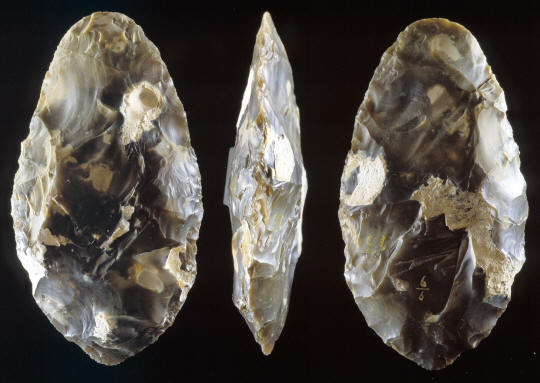
CLICK ON
PICTURE FOR LARGER TRIPLE IMAGE
HANDAXE
ACHEULEAN
ST. ACHEUL,
FRANCE
EST. 350,000
to 300,000 YEARS AGO
AMERICAN MUSEUM OF NATURAL
HISTORY COLLECTION
This handaxe was found in Acheulean deposits at the site of St.
Acheul, near Amiens in northern France. This site dates to the
Middle Pleistocene approximately 350,000 to 300,000 years ago.
Jim G. Shaffer, PhD. describes this handaxe as: "An extremely fine
example of an "almond" shaped biface. The large deep flake removal
scars found in the central areas on both sides, suggest that the
basic shaping was accomplished with a hard hammer. However, the
numerous small, shallow and elongated flake removal scars around the
perimeter of the artifact indicates extensive use of a soft-hammer
to thin, retouch and straighten out the edge. Several small and deep
flake removal scars located along the edges indicates extensive
utilization of the tool. The well defined shape, overall thinness
and relative straight edges reflect a high level of flint knapping
ability."
This handaxe is made of very high quality greenish black/gray
chert. It measures 6 7/8 inches (17.4 cm) long, 3 9/16 inches (9.1
cm) wide and 1 3/8 inches (3.5 cm) thick.
The St. Acheul site is the source of the name of the Acheulean
Tradition in Paleolithic studies. The site is located on the 30
meter terrace of the Somme River and it was excavated between 1903
and 1905. One particularly important aspect of this site is the very
high frequency of flake tools versus core tools such as bifaces. |
|
|
The first handaxes must have developed from the very primitive
chopper-cores of the Oldowan Tradition. In-other-words if the edges of
Oldowan core-tools were used for cutting, chopping, striking, etc, the core-tool bifaces of the
Acheulean Tradition are just a much more refined development for the
need of a tool that would do the same thing only better. |
|
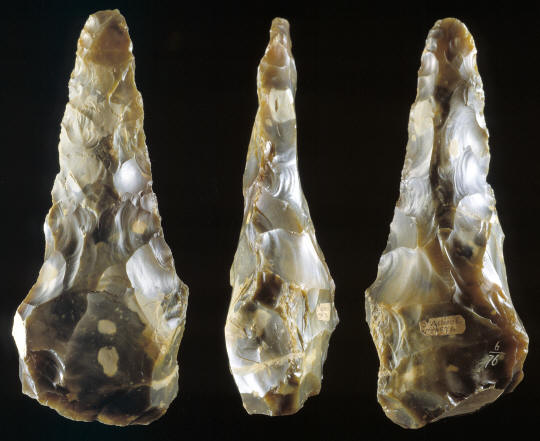
CLICK ON PICTURE FOR LARGER TRIPLE IMAGE
HANDAXE
ACHEULEAN
ST. ACHEUL,
FRANCE
EST. 350,000
to 300,000 YEARS AGO
AMERICAN MUSEUM OF NATURAL
HISTORY COLLECTION
This handaxe was found in Acheulean deposits at the site of St.
Acheul near Amiens in northern France. This site dates to the Middle
Pleistocene and dates to sometime between 350,000 to 300,000 years
ago.
Jim G. Shaffer, PhD. describes this handaxe as: "A good example of
a "Micoquian" or pointed style biface. Both surfaces of this biface
are covered with small, shallow and elongated flake removal scars
indicating that at least the final shaping and retouching of this
artifact was done with a soft hammer. The pointed end has been
extensively retouched to form relatively straight edges, and to make
this section of the artifact significantly thinner than the basal
part. A very interesting feature of this biface is the thick basal
region, Unlike most bifaces the cutting edge is not continuous
around the perimeter of the artifact, indeed the cutting edge
appears to have been purposefully blunted by the removal of flakes
in the basal region. This may have been done with the intent to
facilitate the holding of this artifact in the hand while the
thinner, sharper pointed region of the biface was being used. The
small, deep flake scars along the edges in the basal region may
reflect attempts to thin this section of the artifact."
This handaxe is made of very high quality greenish black/gray
chert. It measures 6 9/16 inches (16.7 cm) long, 2 5/8 inches (6.6
cm) wide and 1 13/16 inches (4.6 cm) thick. |
|
|
Handaxes were manufactured from either small cobbles, nodules or from
large flakes struck from much larger boulders. Handaxes were made by
percussion flaking. The earliest examples were produced with the use of
a hard hammer, in the form of a
stone. Later more skillfully made handaxes were produced with the use of
soft hammers that would have been made from either
antler, bone, ivory or wood. |
|
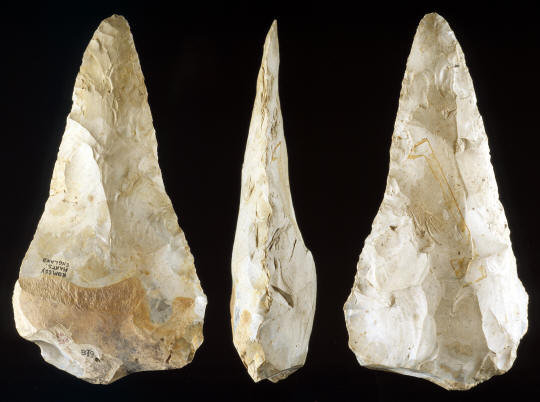
CLICK ON PICTURE FOR LARGER TRIPLE IMAGE
HANDAXE
ACHEULEAN
ROMSEY
HANTS., ENGLAND
EST. 350,000
to 300,000 YEARS AGO
PRIVATE COLLECTION
This handaxe is described as having been collected at Romsey Hants.,
England. This is a "Micoquian" or pointed style biface that is very
nicely made. Both sides have large flake scars and the edges are
fairly straight and skillfully trimmed. This handaxe is made of a
good quality light colored chert and it measures approximately 7 5/8
inches (19.3 cm) long. |
|
|
There has been much speculation about the purpose of
handaxes. They were in use during a very early period in history and
there are no recent cultural references to these forms of tools. Some of
the suggested theories as to their use include: 1. general purpose tools
for cutting, scraping, chopping, hacking and digging, 2. as heavy duty
meat cutting tools for processing medium to large size animals, 3. as
digging tools for excavating plants, burrowing animals or accessing
water, 4. as cores that produced flakes that were in turn used as tools,
5. as bark-stripping tools to access the cambium layer of a tree for
food and 6. as a projectile to be thrown as a discus might be thrown. |
|
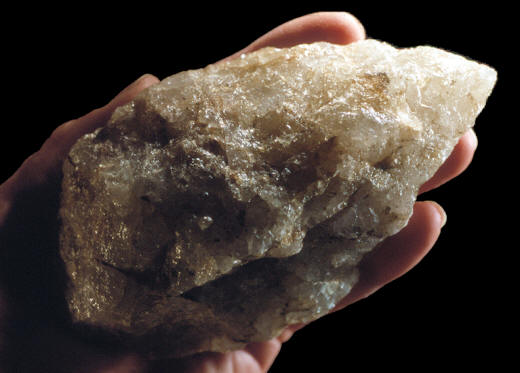
HANDAXE
ACHEULEAN
AFRICA
EST. 350,000
to 300,000 YEARS AGO
AMERICAN MUSEUM OF NATURAL
HISTORY COLLECTION
This handaxe was collected from an Acheulean site in Africa. It
illustrates the range of material that Homo erectus was using to
make bifaces. This handaxe was made from a very poor grade of
quartz. Acheulean handaxes were made from any locally available
stone that could be flaked, no matter how good the quality. This
handaxe measures approximately 5 1/2 inches (14 cm) long. |
|
|
Acheulean handaxes stand out as one of the
most remarkable artifacts produced by early humans. The fact that they
were made for such a long period of time, approximately 1.4 million
years, is most amazing. It's also interesting that scientists still
disagree as to how they may have been used. But if the majority of them
were used as a tool, as many believe, and not only as a core, they were
the most successful tool, as a type, ever invented during the Paleolithic
period. |
|
"REFERENCES"
1961, Braidwood, Robert J., "Prehistoric Men," Flake
Tools, p. 45.
1971, Clark, J. Desmond, "The Horizon History Of Africa," African
Beginnings, p. 26.
1988, Tattersall, Ian, Delson, Eric & Couvering, John Van,
"Encyclopedia of Human Evolution and Prehistory," Acheulean and
Handaxe, pp. 3 & 241.
1993, Schick, Kathy D. and Toth, Nicholas, "Making Silent Stone
Speak,"
How Were Handaxes And Cleavers Made?,
What Were Acheulean Tools Used For?, pp. 238 & 258-259.
1994, Debenath, Andre and Dibble, Harold L., "Handbook Of
Paleolithic Typology, Vol. 1," Bifaces and Cleavers, pp. 130-171.
1996, Fagan, Brian M., "The Oxford Companion To Archaeology,"
Acheulean Tradition, p. 1.
Personal Communication with Jim G. Shaffer, PhD., Case Western Reserve.
|
|
RECENT
LISTINGS HOME
ORDERING |
